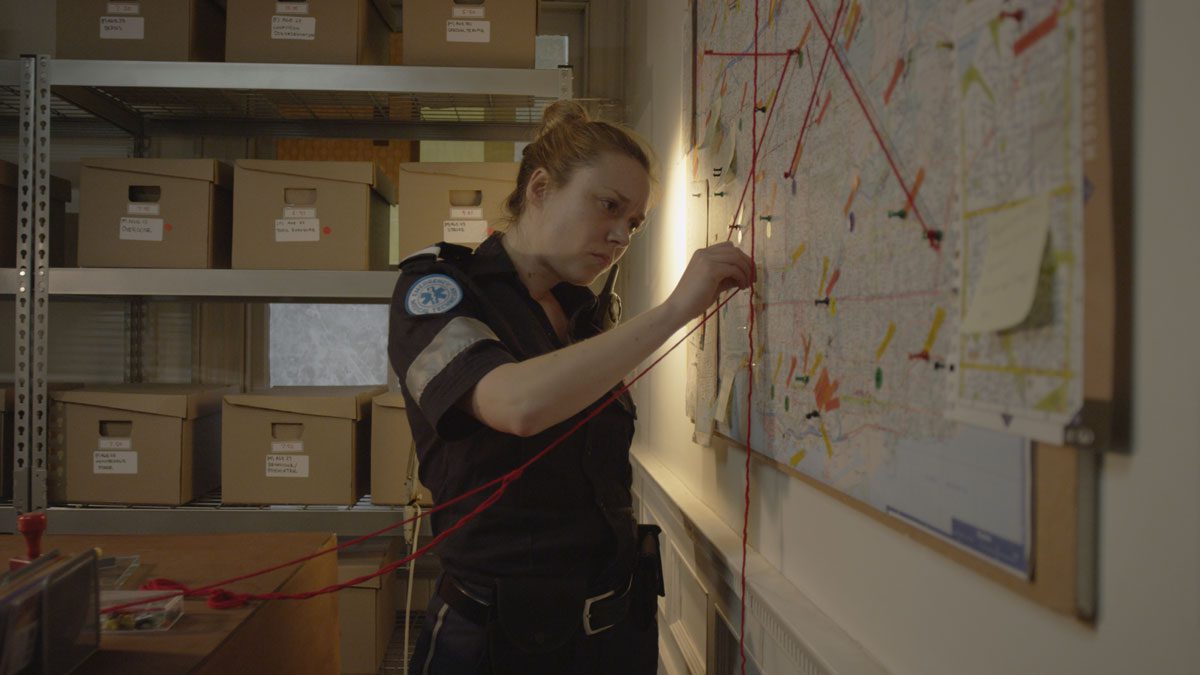What is the message of the play? Why this play now?
Vitals by Rosamund Small was published in 2016 but has a greater impact on audiences post COVID-19. The biggest message I took away from watching Vitals was the importance of providing mental health support to healthcare workers. That said, why show this play now? Post COVID-19, there is more public awareness on the issue of healthcare workers’ mental health. With my mom being a palliative cancer nurse and a frontline worker, I witnessed first-hand the psychological impact the pandemic had on healthcare workers. When I told her about the line “EMS is just a modern funeral director” (Small Part 2 15:05), she confirmed the truth of the statement and explained the history of paramedicine to me. After the show, there was a talk-back with the actor, and local paramedics were also in attendance. They verified the accuracy of the play, of what can happen if workers do not have access to the support they need. I think that this play may help EMS (Emergency Medical Services) workers who are struggling with their mental health feel seen.
How was this theme or message communicated?
Vitals conveys the importance of mental health support for healthcare workers by displaying Anna’s mental health declining as her career continues. Vitals causes the viewer to think critically. The dialogue and blocking add subtle nuance for the audience to notice Anna’s decline, but the play does not specifically say it. Anna does not say “I’m losing my mind,” but audiences see her develop a disregard for the routine and precision she once exuded. As we learned from the talk back, a level 3 paramedic getting sloppy in their routine is the first sign that person needs help. This psychological change was noticeable in the use of props on stage, specifically, the water basin, case files, EMS uniform, and the pill bottle.
When Anna re-lives horrific cases, such as a gory suicide or dead rape victims, she gets more frantic with her hand washing in the basin, trying to wash away the memory of those cases. I thought this was a nice, subtle way to tell the audience how difficult specific cases were for Anna to deal with.

The files each represent a call Anna dealt with, but there was one red file that represented “Scotiabank guy.” The Scotiabank guy was Anna’s first big psychologically traumatizing case. Throughout the show, Anna collects and cleans up each case file. When she gets to the file representing the Scotiabank guy, she puts that folder in a dresser drawer without mentioning him. Later, she takes the file out of the drawer, ready to look back on the memory of his fatality.
Anna tried to save a baby that had been neglected and drowned in a bathtub. Anna later assaults the neglectful mother at the hospital. This causes Anna to get fired and she loses all sense of self. This loss is symbolized by Anna quickly throwing her EMS uniform into the drawer she so carefully removed it from earlier in the play. As previously mentioned, level 3 paramedics are very meticulous about their routine and organization. When Anna throws her uniform away, this is the true signifier that Anna has reached a mentality beyond saving.
Anna’s pill bottle is on stage for the entire play. As an audience member, you do not think anything of it. I thought it was some form of medication the psychiatrist prescribed for her. It is not until Anna tells the audience that she has chosen pills to commit suicide that you finally understand what they are for. When the pills are on stage for the entire show it reiterates that the entire play is not the process of Anna getting fired, but her reflecting on her life as a paramedic after she has already been fired. This plot distinction causes the audience to take a step back and truly reflect on what the play is trying to say: it is a cautionary tale about mental health. Even my thinking that the psychiatrist gave her the pills means that I had assumed the play would end happily with Anna recognizing and wanting to heal from her trauma. But getting help can be a challenge, and Anna even says that the psychiatrist should not be working at the hospital because he provides no real support. How can you want to get better when the resources that you have are so untrustworthy?
Anna’s pill bottle is on stage for the entire play. As an audience member, you do not think anything of it. I thought it was some form of medication the psychiatrist prescribed for her. It is not until Anna tells the audience that she has chosen pills to commit suicide that you finally understand what they are for. When the pills are on stage for the entire show it reiterates that the entire play is not the process of Anna getting fired, but her reflecting on her life as a paramedic after she has already been fired. This plot distinction causes the audience to take a step back and truly reflect on what the play is trying to say: it is a cautionary tale about mental health. Even my thinking that the psychiatrist gave her the pills means that I had assumed the play would end happily with Anna recognizing and wanting to heal from her trauma. But getting help can be a challenge, and Anna even says that the psychiatrist should not be working at the hospital because he provides no real support. How can you want to get better when the resources that you have are so untrustworthy?
This plot distinction causes the audience to take a step back and truly reflect on what the play is trying to say: it is a cautionary tale about mental health.
The second sign of Anna losing herself, that I noticed, was an actual mistake during the production of the show. In the performance that I saw, Anna repeated her neighbour’s failed suicide story. The second time, there was a ringing sound, like an ear ringing. I thought the repetition was purposeful, her hyper fixation on specific cases showing that they are mentally affecting her, even though she denies it. During the talkback, we came to find that the repeated story was, in fact, a mistake and the tech team had played the ringing to get Anna’s actor back on track. However, it is fascinating to reflect on how mistakes in live theatre can heighten subject matter and the play’s experience.
Part 3 of the podcast includes dialogue that tells the audience that Anna’s trauma is causing her to go into a mental decline. The cases this chapter includes are the baby in the bathtub, the drug house, and the severed woman, who was “cut away, at the arms, on both sides.” Ana explains her experience with the woman, stating, “And that was quite– I’m usually pretty good, but that was actually quite, because she’s, she’s been drugged I’m pretty sure so she couldn’t move, and I think that was—I think about that one sometimes” (Part 3 10:53). A drowned baby is considered her ‘best case,’ she was almost shot in the drug house and could not call for backup, and the severed woman was still alive when she had been mutilated. It is no wonder Anna started hating her job after these experiences. Anna’s job is her entire life. In her mind, she is nothing without being a paramedic. At the end of the show Anna says, “I like wolves, I mean I like dogs” (Part 4 16:29) after deciding to keep her neighbour’s neglected dog. Like the Castle Frank jumper who was obsessed with wolves that he hallucinated, by the end of the play Anna talks of wolves too. Anna no longer can say what she means and that is an indicator of the state of her mental health. To the audience, she now has a similar mental state to the Castle Frank jumper.
For the production, design elements like lighting helped convey the severity of cases Anna was talking about. The stage was a simple thrust stage that was split into two halves: one blue and one red, like police lights. Depending on the category of the case Anna would stand on either side of the stage. Intense and gory cases were on the red side of the stage, and odd situational cases were on the blue side. The phone call at the beginning of the show was another way they incorporated tech to indicate Anna’s mental state. At the beginning of the show, the 911 call has long pauses between the operator’s questions and no one answers. In the final minutes of the show, the phone call plays again but this time Anna responds to the 911 worker. As an audience member you realize that Anna was losing herself before the play even started, and the show is her running over her career after she has already lost her job.

Vitals displays the importance of EMS mental health support through Anna’s character because Anna deeply cared about saving people. She was burnt out and cynical, but her life’s purpose was to help others. As an audience member you can acknowledge that Anna made poor choices, but getting fired was not entirely her fault. She did not receive the proper support she needed to have a successful career. In the end, the system failed her. If there were proper mental health resources, the psychiatrist would have helped Anna seek greater support and she would have had a space to put her grief. The signs of her losing herself would have been caught sooner and she would not have joined the wolves.
Works Cited
Small, Rosamund. Vitals. PlayME, Parts 1-4, CBC, 26 Oct. 2018, http://www.playmepodcast.com
About the author:

Asia Sinkovic is in their first year of the BFA Acting program at the University of Windsor. Asia is going to be in the upcoming University Players 2024- 2025 season as Gander in Charlotte’s Web! In their free time, Asia likes to listen to a wide array of music and play Animal Crossing. They also enjoy Mario Kart tournaments with their friends! Asia is very passionate about queer activism and representation in media and educational spaces. In their time at UWin, they hope to open conversations about representation and create spaces where all students can feel seen.
Leave a comment